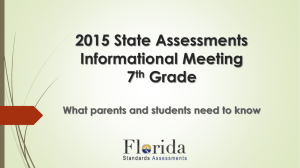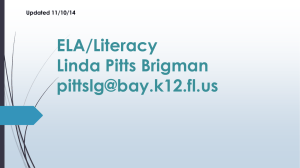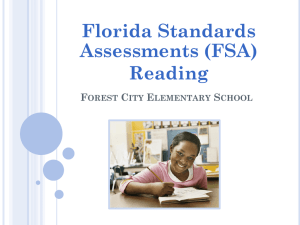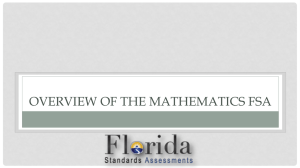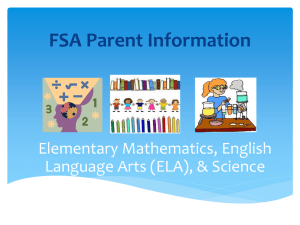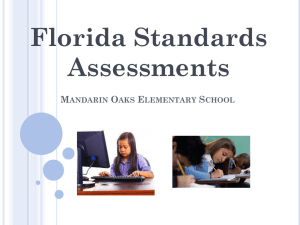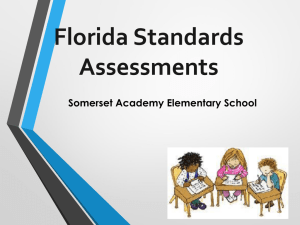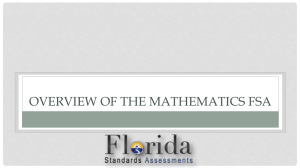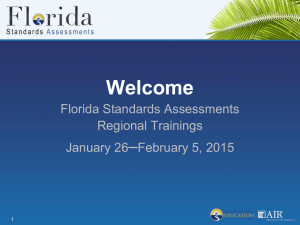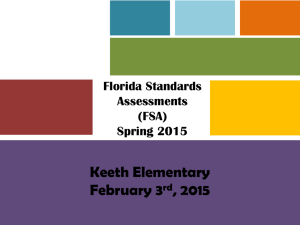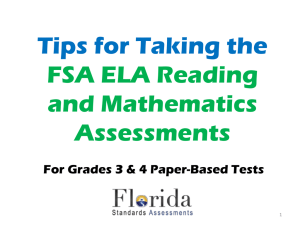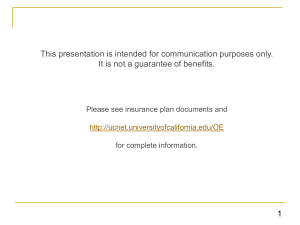Florida Standards Assessments
advertisement
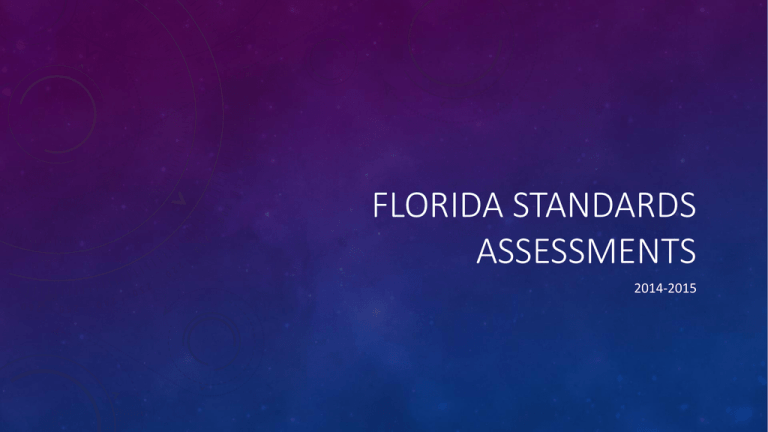
FLORIDA STANDARDS ASSESSMENTS 2014-2015 FSA MATHEMATICS ASSESSMENTS COMPUTER-BASED TESTING FOR 2014-2015 • Grades 3-4 • Grades 5-6 • Grades 7-8 Paper-based test Computer-based test Computer-based test (1st Year) • Algebra 1 & Geometry EOC Computer-based test FSA MATHEMATICS ASSESSMENTS CALCULATORS AND REFERENCE SHEETS FOR 2014-2015 • Grades 3-6 No calculators permitted (disabled on CBT) • Grades 7-8 Calculator permitted (enabled) for designated sections and items (has not been determined as of yet.) • No hand-held calculators are permitted • Calculators can be downloaded for use in the classroom • Reference sheets will not be provided for the FSA • Formulas may be included with the item if needed • Conversions, Z tables, etc. will be in a pop up window if needed FSA MATHEMATICS ASSESSMENTS TEST DESIGN SUMMARY AND BLUE PRINT Grade 3 Grade 5 Grade 4 Reporting Category % of Test Operations, Algebraic Thinking, and Numbers in Base Ten 48 Numbers and OperationsFractions 17 Measurement, Data, and Geometry 35 Reporting Category % of Test Reporting Category % of Test 39 Operations and Algebraic Thinking 21 Numbers and Operations in Base Ten 21 Operations, Algebraic Thinking, and Numbers in Base Ten 28 Numbers and Operations in Fractions 25 Numbers and OperationsFractions Measurement, Data, and Geometry 33 Measurement, Data, and Geometry 33 FSA MATHEMATICS ASSESSMENTS TEST DESIGN SUMMARY AND BLUE PRINT Grade 6 Reporting Category Grade 7 % of Test Ratio and Proportional Relationships 15 Expressions and Equations Geometry Reporting Category Grade 8 % of Test Ratio and Proportional Relationships 25 30 Expressions and Equations 21 15 Geometry 23 Statistics and Probability 19 Statistics and Probability The Number System 21 The Number System Reporting Category % of Test Expressions and Equations 30 Functions 25 Geometry 27 Statistics and Probability and The Number System 18 16 15 FSA MATHEMATICS ASSESSMENTS TEST DESIGN SUMMARY AND BLUE PRINT Algebra 1 EOC Reporting Category Geometry EOC % of Test Reporting Category % of Test Algebra and Modeling 41 Congruence, Similarity, Right Triangles, and Trigonometry 46 Functions and Modeling 40 38 Statistics and The Number System 19 Circles, Geometric Measurement, and Geometric Properties with Equations Modeling with Geometry 16 PERCENTAGE OF POINTS BY DEPTH OF KNOWLEDGE LEVEL Grade DOK Level 1 DOK Level 2 DOK Level 3 3-8 10% - 20% 60% - 80% 10% - 20% Algebra 1 10% - 20% 60% - 80% 10% - 20% Geometry 10% - 20% 60% - 80% 10% - 20% NAVIGATING THE MATH ITEM SPECIFICATIONS • Content Standards • Assessment Limits • Text Types • Acceptable Response Mechanisms* • Use of Calculator • Question Complexity • Sample Item Stems ACCEPTABLE RESPONSE MECHANISM Equation Response Graphic Response - Drag and Drop ACCEPTABLE RESPONSE MECHANISM Multi-Select Response Graphic Response- Drawing/Graphing and Hot Spot ACCEPTABLE RESPONSE MECHANISM Natural Language Response Multiple Choice Response Tips/Strategies to Help My Child Succeed on the Math FSA 1. 2. 3. 4. 5. 6. 7. 8. 9. Always read math problems completely before beginning calculations. Draw a picture that will help you solve the problem. Do not stay “stuck” on any particular problem; choose the answer(s) you think is best. Then go on with the rest of the test. Always double check your work if there is time. Ask yourself if your answer makes sense. Don’t be afraid to use your fingers if it will help. Practice previous lessons on Mathletics/IXL before FSA testing. Exposing yourself to all of the content will increase your understanding and recognition of tested material. Continue to work on newly assigned IXL math lessons. Finish the test. Any unanswered questions will be marked incorrect. FSA ELA ASSESSMENTS COMPUTER BASED TESTING 2014-2015 • Grades 3-4 • Grades 5 • Grades 6-8 Paper-based test Computer-based test (1st Year) Computer-based test FSA ELA ASSESSMENTS TEST DESIGN SUMMARY AND BLUE PRINT Grade 3 Grade 4 Reporting Category % of Test Key Ideas and Details 15-25 Reporting Category Grade 5 % of Test Reporting Category % of Test Key Ideas and Details 15-25 Key Ideas and Details 15-25 25-25 Craft and Structure 25-35 25-25 Craft and Structure 25-35 25-35 Integration of Knowledge and Ideas 25-35 Integration of Knowledge and Ideas Integration of Knowledge and Ideas Language and Editing 15-25 Language and Editing 15-25 Language and Editing 15-25 Craft and Structure Text-based writing TBD Text-based writing TBD FSA ELA ASSESSMENTS TEST DESIGN SUMMARY AND BLUE PRINT Grade 6 Reporting Category Grade 7 % of Test Reporting Category Grade 8 % of Test Reporting Category % of Test Key Ideas and Details 15-25 Key Ideas and Details 15-25 Key Ideas and Details 15-25 Craft and Structure 25-25 Craft and Structure 25-25 Craft and Structure 25-35 Integration of Knowledge and Ideas 25-35 Integration of Knowledge and Ideas 25-35 Integration of Knowledge and Ideas 25-35 Language and Editing 15-25 Language and Editing 15-25 Language and Editing 15-25 Text-based writing TBD Text-based writing TBD Text-based writing TBD PERCENTAGE OF POINTS BY DEPTH OF KNOWLEDGE LEVEL Grade DOK Level 1 DOK Level 2 DOK Level 3 3-11 10% - 20% 60% - 80% 10% - 20% NAVIGATING THE ELA ITEM SPECIFICATIONS • Content Standards • Assessment Limits • Text Types • Acceptable Response Mechanisms* • Task Demand • Sample Item Stems ACCEPTABLE RESPONSE MECHANISMS • Grid Item ACCEPTABLE RESPONSE MECHANISMS • Two-Part Hot Text ACCEPTABLE RESPONSE MECHANISMS • Multi-select ACCEPTABLE RESPONSE MECHANISMS • Open Response ELA EDITING TASK ITEMS GRADES 3-8 ELA TEXT-BASED WRITING GRADES 4-11 • Types of Writing: • Informative/Explanatory • Opinion/Argumentative Writing • Scoring: • Purpose, Focus and Organization (4-point rubric) • Evidence and Elaboration (4-point rubric) • Conventions of Standard English (2-point rubric) ELA TEXT-BASED WRITING GRADES 4-11 ACCEPTABLE TEXT TYPES Informational Text Literary Text Primary/Source Nonfiction Literary Nonfiction Secondary Sources/Nonfiction Literary Fiction Functional Materials ELA TEXT LENGTHS TIPS/STRATEGIES TO HELP MY CHILD SUCCEED ON THE READING FSA 1. 2. 3. 4. 5. 6. 5. 6. Monitor that your child reads every day. Ask questions and that require your child to “prove” their answer with supporting facts and evidence from the text. Ask your child to explain their homework. Encourage them to use academic language. Focus on vocabulary in context. Expose your child to multimedia elements such as: *audio presentations *slideshows *graphical elements Complete See Reader lessons on a weekly basis with at least 80% accuracy. Visit FSASSESSMENTS.ORG to review released sample tests. CONCLUDING THOUGHTS • Questions/Concerns
